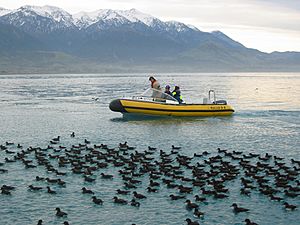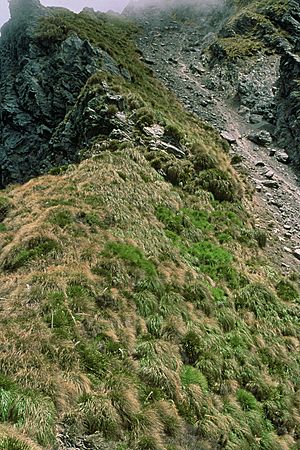Hutton's shearwater facts for kids
Quick facts for kids Hutton's shearwater |
|
|---|---|
 |
|
| Conservation status | |
| Scientific classification | |
| Genus: |
Puffinus
|
| Species: |
huttoni
|
The Hutton's shearwater (Puffinus huttoni) is a special type of seabird that lives in the ocean. It's also known as the kaikoura tītī in Māori. This bird is part of a group called Procellariidae, which includes petrels and shearwaters.
Hutton's shearwaters spend almost all their lives at sea. They only come to land to breed. These amazing birds are found in the waters around Australia and New Zealand. But here's the unique part: they only nest in two places in the mountains of New Zealand! These two spots are in the Seaward Kaikoura Range. Sadly, six other places where they used to nest have been destroyed by wild pigs. Because of this, people have started a new, safe nesting area near the town of Kaikoura to help them survive.
Contents
What They Look Like
This bird was named after Frederick Hutton, who used to be in charge of the Canterbury Museum in New Zealand.
Hutton's shearwaters are medium-sized birds. They weigh about 350 grams, which is less than a can of soda. Their wings can spread out to about 75 centimeters wide. They are brown on top and white underneath. They have a brown band around their neck and dark edges on the underside of their wings. Their beak is dark grey, and their feet are pinkish with dark webs. You can tell them apart from other similar birds, like the fluttering shearwater, because of their dark grey "armpits." When they are at their nesting sites, they make a loud, cackling sound.
How They Find Food
Hutton's shearwaters eat in the open ocean. They mostly hunt small fish and tiny sea creatures called krill. They can dive deep, sometimes up to 20 meters underwater, to catch their food!
These birds have long beaks that are great for catching prey underwater. They can dive from a few meters above the surface. Sometimes, they paddle slowly on the water, looking for food with their heads dipped under. Once they spot something, they dive down, using their partly open wings to push themselves through the water.
Where Hutton's Shearwaters Live

These birds live their whole lives at sea, except when it's time to have babies. From September to March (spring and summer in New Zealand), the adult birds fly to New Zealand waters. You might see them anywhere along the New Zealand coast. However, most of them feed off the eastern side of the South Island. This is especially true between Cook Strait and Banks Peninsula. You can often see large groups of them off the Kaikoura Coast during the summer.
When it's not breeding season, they usually live in Australian waters. Scientists put small trackers on some young birds. These trackers showed that some young Hutton's shearwaters fly all the way around Australia! They travel in a counter-clockwise direction for about 4 to 5 years before they are old enough to have their own chicks.
How They Raise Their Young

Hutton's shearwaters are very special because they are the only seabirds that nest high up in the mountains! They dig burrows (tunnels) at altitudes of 1200 to 1800 meters. This is in the sub-alpine and alpine zones, which are very high up.
Long ago, they used to nest in both the Seaward and Inland Kaikoura mountains. The Māori would collect the young birds, which they called "muttonbirds," for food. Today, their nesting is only in two places in the Seaward Kaikoura Range. One colony, at the top of the Kowhai River, has over 100,000 pairs of birds! The other is smaller, with about 8,000 pairs, on private land at Shearwater Stream.
Even though scientists described this bird in 1912, no one knew where they nested until 1964! They dig their burrows into steep grassy slopes. There's usually one burrow every 2 square meters. The female bird lays one white egg in November. The egg is kept warm for about 50 days until it hatches. The chicks then stay in the burrow for around 80 days before they are ready to fly out to sea.
Protecting Hutton's Shearwaters
In 1964, eight nesting colonies were found. But now, only two are left. The other colonies, which were at lower altitudes, were destroyed by wild pigs that were brought to the area.
The main animals that hunt Hutton's shearwaters are stoats. Stoats are small, ferret-like animals that were also introduced to New Zealand. They kill about 0.25% of adult birds and 12% of chicks each year in their nesting burrows. However, the overall number of shearwaters is still growing, so stoats are not the biggest problem.
Some parts of the nesting colonies are on very steep and unstable land. Animals like deer, goats, and pigs eating plants in these areas have caused erosion. This erosion has damaged the shearwater burrows and hurt the bird population. But, controlling the number of pigs has helped the plants grow back. This means less erosion and less damage to the burrows.
Even though there are about 114,000 breeding pairs, both remaining nesting colonies are at risk from predators or erosion. So, in 2005, a new colony called Te Rae o Atiu was started on the Kaikoura Peninsula. In April 2005, 10 young birds were moved there. Then, about 100 more young birds were moved each March in 2006, 2007, 2008, 2012, and 2013.
The chicks were moved from the Kowhai colony and hand-fed in special artificial burrows. This helped them to feel like the new colony was their home. Since 2010, some of these birds have returned to Te Rae o Atiu to breed! In February 2010, the Hutton's Shearwater Charitable Trust built a special fence around the 2-hectare (about 5-acre) site. This fence keeps predators out.
Young shearwaters can get confused by bright lights. This causes them to crash-land in towns. To help with this, the Kaikoura District Council is trying out new streetlights. These lights can be changed during the time when the young birds are learning to fly.
Images for kids
See also
 In Spanish: Pardela de Hutton para niños
In Spanish: Pardela de Hutton para niños






